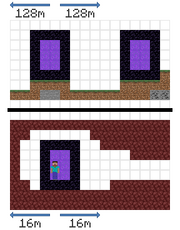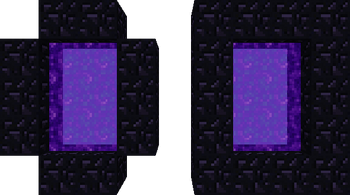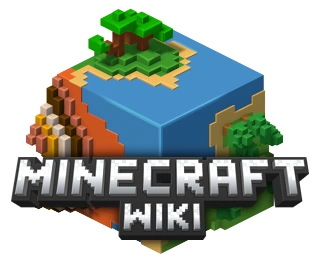The creation of nether portals can be used for a variety of different means. This page lists some of the implications of these portal mechanics.

Overworld portals can go a long way, one way.

Nether portals go a relatively short distance; only the left Overworld portal is in range.
ネザーポータルを作る準備[]
ネザーというディメンションに行くには、まず黒曜石を集める必要がある。 基本的な材料は次の通り。
- 黒曜石10個以上。ネザーポータルには、最低、横2マス、高さ3マス、奥行き1マスの縦、横を黒曜石に囲まれた空間が必要である。
- 火打石と打ち金。ネザーポータルを起動させるために使う。
- ダイヤモンドのツルハシ。黒曜石を集めるのに必須である。
ただし、黒曜石を採掘せずとも、ポータルを作ることも可能。その場合、任意のブロックで型を作り、そこに溶岩入りバケツで溶岩源を設置した後、水入りバケツで水を流すことを繰り返す。
黒曜石採掘[]
黒曜石採掘に行こう。オススメの場所は次の場所である。この際、溶岩に落ちないように注意しよう。
- Y10以下の場所。この高度になると溶岩で満たされていることが多い。
ここに着いたら、溶岩だまりを探そう。Y12の高度で探すとよい。見つけたら水入りバケツで溶岩に水を流そう。この際、生成された黒曜石を採掘したら下の溶岩で燃えることのないよう、水は流したままにしよう。あとは、端の黒曜石から採取すればよい。14個以上集めたら地上に戻ろう。
ネザーポータル作り![]

最小のネザーポータル。最低、この大きさにする必要がある。
集めた黒曜石で好きな場所にネザーポータルの枠を作ろう。ネザーポータルは任意の形、大きさにできるが、最低限画像のようにする必要がある。枠を作ったらそこに火打ち石と打ち金で火をつけるとネザーポータルのできあがり。
火打ち石と打ち金を使わない場合は、原木などの可燃ブロックに引火させることで、ポータルを完成させることができる。
ネザーへ行こう[]
ネザーポータルが出来たら、ネザーポータルに入ります。すり抜けるのではなく、ネザーポータルの紫の部分に約4秒間いるとネザーにスポーンします。
最初のポータルの位置に注意せよ[]
ネザーポータルは溶岩の中、何もない空中、ブロックの中を避けて生成される。そのため、それらの場所にポータルが生成されることはないが、そのすぐそばに生成されることがある。ポータルが生成された場所のすぐ近くに溶岩源があり、そこから溶岩が流れてくることもある。更に、ポータルは1ブロックしかない崖の上に生成されることもある。
オーバーワールドの Mob にも注意[]
ネザーポータルは、プレイヤーだけでなく、Mob も通過可能だ。そのため、オーバーワールドの敵対的 Mob がポータルを通じてネザーに溜まっていることがある。もしも、ネザーに入った時に近くにクリーパーが溜まっていた場合、溶岩海に落ちる穴が開かないように注意しよう。ネザーラックは非常に柔らかいため、クリーパーの爆発で簡単に壊れてしまうからだ。
Farming obsidian[]
See Tutorials/Obsidian farming.
Portals can be built in networks[]
No more than 64 Nether blocks (256 Overworld blocks) apart, in the manner reminiscent of the gates in the Stargate series. You should build portals at (this is the maximum ideal distance, but they can be built as close to 16 Overworld blocks apart, if the co-ordinates are accurate) 64 Nether block intervals, even if you are not normally going to use these gates. This is so that if you use Nether portals for long distance travel, and your usual Overworld destination portal becomes inaccessible for some reason, (due to large gravel caveins, lava, water, or you have an automated activation system and forgot to turn it on) you will still have a reasonably close backup gate, which will get you back into your gate network.
Likelihood of 2 overworld portals linking to the same Nether portal[]
Overworld portals that are within 1024 distance of each other on both X and Z axis are almost always going to link to the same Nether realm portal on initial construction because 1024 translates to a distance of 128 in the Nether Realm, and the game checks for existing portals within 128 "radius" around the destination (the 257×257×128 box).
Pairing portals[]
To setup pairs of Nether portals properly so that they reliably travel to each other, it is best to build both portals manually. Build at desired location X,Y,Z in the Overworld. Then travel to the Nether. And then dig your way to X/8, Y, Z/8, and build a portal there.
A less precise method would be to temporarily deactivate all portals within a 128 block "radius" from within the Nether. Through death or with the aid of a second player, entering a new portal from the Overworld will force the creation of a new portal within the Nether which the Overworld portal should prefer. This is not recommended as it limits how close Overworld portals can be placed due to the zone of exclusions and can lead to unpredictable placement of the resulting portal.
Zones of exclusion[]
The Nether portal spawning algorithm can only spawn portals that are within a 33×33 block column centered on the destination. This will often cause it to spawn a portal at a location significantly different than the corresponding location in the other world. The larger the distance between two linked portals, the larger the zone of exclusion. This zone is the area in each world where you cannot build another portal without breaking the link between the first two portals. One way to think of this zone is as spheres around each portal, each of a true radius equal to its distance to the other. For example, if the Overworld portal was at (0,50,0) and the Nether portal at (0,100,0), then each portal is 50 meters away from the other. In this (simple) case, if a Nether portal was built closer than 50 meters to (0,50,0), then the Overworld portal will now link to it.
If you wish to ensure that two portals link together, manually build portals as close as possible in all 3 coordinate axes. It doesn't have to be exact, or even all that close, if the player ensures that no other portals will be constructed in the exclusion zone created by the difference.
1-way long distance teleport[]
The portal choosing algorithm can be used for long distance travel by manual construction at carefully selected coordinates. If the player has a portal in the Overworld at (0,64,0) but makes a Nether portal at (127,64,127) with its perfect Overworld pair at (1016, 64, 1016), then the portal at (0,64,0) will go to the Nether portal correctly (1-way trip) because it is the only portal available within the 128 search distance along X and Z horizontal axes of the expected Nether portal position of (0,64,0). In about 15 seconds, the player can then travel 1436 meters in the Overworld. This specific form of fast travel by portal is one-way, since the Nether portal will not find this Overworld portal. Given that a railway in the nether would need to span only 180 meters to go this distance, it is usually not worth making such portal links. However, it is theoretically possible to make a one-way ring of portals, with each Overworld to Nether jump going a long distance, but such a ring would easily be disrupted due to the huge exclusion zones created.[1]
Non-exploit water ladder replacement[]
The Nether portal is an also entirely viable, two-way replacement for the water or conventional ladder.[2] Note that if you want to travel a vertical distance of h from a point (X, Y, Z) in the Overworld to (8*X, Y+h, 8*Z) in the Nether, there must be no other Overworld portal within a distance of 8*h from (X, Y, Z) (i.e. (X/8)² + (Y/1)² + (Z/8)² = h², note that Y is not divided by 8). That is, if you want to travel large vertical distances, there must be no horizontally close portal. (This holds for a portal from the Overworld to the Nether. The reverse direction (Nether to Overworld) was not discussed here.)
2-in-1 Nether portals[]
It is possible to end up in a situation where a Nether portal "randomly" places the player in 1 of 2 possible Overworld destination portals. This is simply because the Nether portal has two effective coordinates as it is 2 blocks wide, say (X, Y, Z) on the left, and (X+1, Y, Z) on the right. If the player entered on the left side, (X, Y, Z) translates to (X*8, Y, Z*8) in the overworld and the game picks the portal closest to that. If the player entered on the right side, (X+1, Y, Z) translates to (X*8+8, Y, Z*8) and the game picks a portal closest to that point instead. This situation occurs when the Nether portal's location is roughly equidistant between the 2 Overworld portals (within 8 blocks overworld distance difference). However, building 2 Nether portals side by side is probably better for destination clarity than building a 2-in-1 portal. It is possible to span distances with pairs of portals in this way, though normally faster to simply walk through the Nether.[3]
Spawning a portal in the air[]
It is possible for a destination portal (either in the Nether or in the Overworld) to spawn floating in the air. If your portal spawns in the air, it will generate a 1×2×1 obsidian platform in the front and back of the portal. This can only occur if there is no possible spawn location in the entire 33×33×128 column of search region to find a suitable spot to place a fresh new portal 'and' there are no existing portals within the 128 block "radius" to link to.
Structure finder[]
With some luck, making a portal underground, entering the Nether and making another portal out of the other's proximity may create a portal in a stronghold, a cavern or even an abandoned mine shaft, all of which may contain a variety of rare minerals. (even diamonds, but the starting portal must be built under layer 16.)
References[]
| 新人向け |
| ||||||||||||
|---|---|---|---|---|---|---|---|---|---|---|---|---|---|
| 全般 | |||||||||||||
| チャレンジ |
| ||||||||||||
| 建築 | |||||||||||||
| 生産 |
| ||||||||||||
| エンチャントと製錬 | |||||||||||||
| ブロック破壊 |
| ||||||||||||
| メカニズム |
| ||||||||||||
| サーバー |
| ||||||||||||
| 技術的なチュートリアル |
| ||||||||||||
| 古いチュートリアル |
| ||||||||||||
